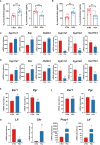Transcriptome profiling reveals superovulation with the gonadotropin-releasing hormone agonist trigger impaired embryo implantation in mice
- PMID: 38469140
- PMCID: PMC10925639
- DOI: 10.3389/fendo.2024.1354435
Transcriptome profiling reveals superovulation with the gonadotropin-releasing hormone agonist trigger impaired embryo implantation in mice
Abstract
Introduction: Superovulation is a critical step in assisted reproductive technology, but the use of human chorionic gonadotropin (hCG) as a trigger for superovulation can result in ovarian hyperstimulation. Thus, the use of Gonadotropin-releasing hormone agonist (GnRHa) trigger has been increasingly adopted, although it has been associated with a higher rate of pregnancy failure compared to natural cycles. This study aimed to investigate the effect of GnRHa trigger on embryo implantation in a mouse model.
Methods: Mice in the superovulation (PG) group were administered 7.5 IU of PMSG, followed by the injection of 3.5 μg of GnRHa (Leuprorelin) 48 h later, while mice in the control group (CTR) mated naturally. We compared the number of oocytes, blastocysts, and corpus luteum between the two groups and the implantation sites after the transfer of natural blastocysts. Ovaries, uterus, and serum 2 and 4 days after mating were collected for qRT-PCR, transcriptome sequencing, and hormone assays.
Results: The PG group had more oocytes, blastocysts, and corpus luteum after superovulation than the CTR group. However, the mRNA expression of leukemia inhibitory factor (Lif) and the number of implantation sites were reduced in the PG group. The ELISA assay revealed that superovulation increased ovarian estrogen secretion. The transcriptome analysis showed that superphysiological estrogen led to a response of the uterus to a high estrogen signal, resulting in abnormal endometrium and extracellular matrix remodeling and up-regulation of ion transport and inflammation-related genes.
Conclusion: Our findings suggest that a combination of PMSG and GnRHa trigger impaired embryo implantation in mice, as the excessive uterine response to superphysiological estrogen levels can lead to the change of gene expression related to endometrial remodeling, abnormal expression of uterine ion transport genes and excessive immune-related genes.
Keywords: gonadotropin-releasing hormone agonist; ovary; superovulation; transcriptome; uterine receptivity.
Copyright © 2024 Li, Han, Yang, Li and Wu.
Conflict of interest statement
The authors declare that the research was conducted in the absence of any commercial or financial relationships that could be construed as a potential conflict of interest.
Figures






Similar articles
-
Superovulation with gonadotropin-releasing hormone agonist or chorionic gonadotropin for ovulation trigger differentially affects leukocyte populations in the peri-implantation mouse uterus.F S Sci. 2021 May;2(2):198-206. doi: 10.1016/j.xfss.2021.03.003. Epub 2021 Mar 20. F S Sci. 2021. PMID: 35559753
-
Superovulation with human chorionic gonadotropin (hCG) trigger and gonadotropin releasing hormone agonist (GnRHa) trigger differentially alter essential angiogenic factors in the endometrium in a mouse ART model†.Biol Reprod. 2020 Apr 24;102(5):1122-1133. doi: 10.1093/biolre/ioaa014. Biol Reprod. 2020. PMID: 31995151
-
[Effect of GnRHa controlled ovarian hyperstimulation on mouse embryo implantation and its mechanism].Sheng Li Xue Bao. 2018 Oct 25;70(5):489-496. Sheng Li Xue Bao. 2018. PMID: 30377687 Chinese.
-
GnRH agonist trigger for the induction of oocyte maturation in GnRH antagonist IVF cycles: a SWOT analysis.Reprod Biomed Online. 2016 Mar;32(3):274-85. doi: 10.1016/j.rbmo.2015.12.007. Epub 2016 Jan 6. Reprod Biomed Online. 2016. PMID: 26803205 Review.
-
Gonadotropin-releasing hormone agonist for ovulation trigger - OHSS prevention and use of modified luteal phase support for fresh embryo transfer.Ups J Med Sci. 2020 May;125(2):131-137. doi: 10.1080/03009734.2020.1736696. Epub 2020 May 4. Ups J Med Sci. 2020. PMID: 32366146 Free PMC article. Review.
Cited by
-
Buserelin shortens the estrus-to-ovulation interval and improves the pregnancy outcomes in gilts treated with a fixed-time artificial insemination.Front Vet Sci. 2025 Jun 18;12:1612713. doi: 10.3389/fvets.2025.1612713. eCollection 2025. Front Vet Sci. 2025. PMID: 40607362 Free PMC article.
-
Dietary supplementation with N-acetyl-L-cysteine ameliorates hyperactivated ERK signaling in the endometrium that is linked to poor pregnancy outcomes following ovarian stimulation in pigs.J Anim Sci Biotechnol. 2024 Nov 6;15(1):148. doi: 10.1186/s40104-024-01109-1. J Anim Sci Biotechnol. 2024. PMID: 39501409 Free PMC article.
-
Impact of Elevated Oestrogen Levels on hCG Trigger Day on Clinical Pregnancy Outcome and OHSS Incidence in Long-Acting GnRHa Down-Regulated IVF/ICSI-ET Cycles.Int J Womens Health. 2025 Jul 14;17:2075-2084. doi: 10.2147/IJWH.S520376. eCollection 2025. Int J Womens Health. 2025. PMID: 40689416 Free PMC article.
-
Estrogen-Regulated Proline-Rich Acidic Protein 1 in Endometrial Epithelial Cells Affects Embryo Implantation by Regulating Mucin 1 in Mice.Biomolecules. 2025 Jun 11;15(6):852. doi: 10.3390/biom15060852. Biomolecules. 2025. PMID: 40563492 Free PMC article.
References
MeSH terms
Substances
LinkOut - more resources
Full Text Sources

